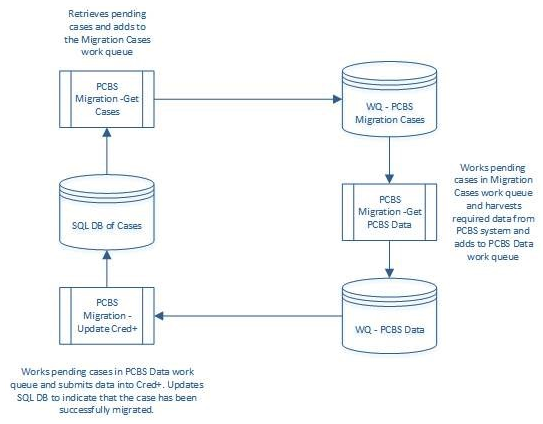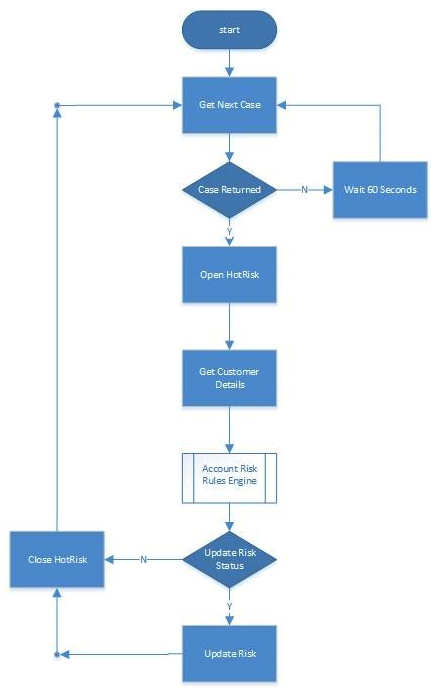A) It's best practice to keep application logic in one business object so that there is a single point of reference.
B) It's good practice to split application logic into multiple objects so that the process is more efficient.
C) It's good practice to keep application logic in one business object so that developers know where to find.
D) It's good practice to keep application logic in one business object to minimize the process dependencies.
E) It's a good practice to split application logic into multiple objects to minimize the process dependencies.
F) It's a good practice to split application logic into multiple objects to minimize the effect of change.
G) It's a good practice to keep application logic in one business object so that the process is more efficient.
Correct Answer

verified
Correct Answer
verified
Multiple Choice
Which of the following statements about using Work Queue designs to split a business process into a multi part robotic solution is correct? 1. Using multiple Work Queues and Processes for the different stages of the business process is a valid design option to split a business process into a multi part robotic solution. 2. Using a single Work Queue and deferring cases for future processing is a valid design option to split a business process into a multi part robotic solution. 3. Using an item's status to control when to work it is a valid design option to split a business process into a multi part robotic solution. 4. You cannot split a business process into a multi part robotic solution.
A) 1 and 2 Only
B) 4 only
C) 1 and 3
D) 1, 2 and 3
Correct Answer

verified
Correct Answer
verified
Multiple Choice
MedBank have recently introduced a new Credit Card platform Cred+. There is a requirement to migrate account and card details from the existing banking platform PCBS on to Cred+. Account IDs of the cases requiring data transfer will be held on a SQL database. The requirement is that, for each account ID specified on the SQL database, the following data must be read from the PCBS application and input into the Cred+ application: Account ID Product Type Name Address Date of Birth Card PAN (Primary Account Number or credit card number) Card Issue Date Card Expiry Date Once the data has been successfully input into Cred+ the correct record on the SQL database will be updated to indicate data transfer is complete. All work queues will be encrypted, however due to the sensitivity of the data, MedBank insist that a single robot account does not have access to both PCBS and CRED+ systems. The following high level design has been proposed:  Which of the following statements about the solution design are correct? (Choose two.)
Which of the following statements about the solution design are correct? (Choose two.)
A) If the PCBS application suffers an outage, all Blue Prism processes specified in this design must stop processing immediately.
B) The solution enables multiple instances of the Get PCBS Data and Update Cred+ processes to run without risk of collision.
C) There is a risk that the outcome of a data transfer will not be recorded in the SQL database.
D) To reduce the elapsed time of the end to end process, the Get Cases process should be run across multiple machines.
E) The Process Get PCBS Data should be stopped if the Cred+ application suffers an outage to prevent a backlog of cases in the PCBS Data work queue.
F) Such sensitive data should not be stored in a Blue Prism work queue.
Correct Answer

verified
B,E
Correct Answer
verified
Multiple Choice
If a solution is to make use of a queue with Maximum Attempts greater than 1, what should the designer put in place? (Choose two.)
A) A decision whether or not to use an available retry item after marking an item as an exception.
B) A decision whether or not to use an available retry item before marking an item complete.
C) Logic to ensure that the next attempt to work a case is executed on a different machine from the previous attempt.
D) Logic to ensure that the next attempt to work a case is executed on the same machine as the previous attempt.
E) Logic to identify the progress made by previous attempts to work a case.
Correct Answer

verified
Correct Answer
verified
Multiple Choice
ProSafe credit reference agency retrieves data from bank and other credit providers where customers have missed payments or gone into default. The data is very sensitive and fed directly into a Blue Prism work queue via a web service. Blue Prism process must process the data within 4 hours. The Blue Prism solution runs continuously and each case takes approximately 30 seconds to process. It is expected that an average of 10,000 cases per day will be required and up to 10 Blue Prism robots are available. The Blue Prism solution is sown below:  For each case of the process will access the customer account in the HotRisk system and, where an account exists, harvest the data which will be fed along with the Work Queue data into a rules engine. The rules engine is a Blue Prism process that does not interact with any target system. It merely consumes data and, via a complicated series of decision and choice stages, determines the new customer risk factor. There is to be no scheduler used. Instead the Process Controllers who work in shifts to provide 24 hour support will stop and start process instances in line with Work Queue volumes. As a Blue Prism process solution designer, who is reviewing the solution, which of the following would concern you? (Choose three.)
For each case of the process will access the customer account in the HotRisk system and, where an account exists, harvest the data which will be fed along with the Work Queue data into a rules engine. The rules engine is a Blue Prism process that does not interact with any target system. It merely consumes data and, via a complicated series of decision and choice stages, determines the new customer risk factor. There is to be no scheduler used. Instead the Process Controllers who work in shifts to provide 24 hour support will stop and start process instances in line with Work Queue volumes. As a Blue Prism process solution designer, who is reviewing the solution, which of the following would concern you? (Choose three.)
A) The solution is not scalable.
B) The process does not have an end stage.
C) The rules engine has been built in a process not an object.
D) The process opens and closes the HotRisk system for each case.
E) The data is too sensitive for automated processing.
F) There is no scheduler.
Correct Answer

verified
Correct Answer
verified
Multiple Choice
A process is required for a client in the banking sector that involves using an application to transfer funds between accounts. A strong security model is in place to prevent any malicious activity but the client is nervous about the risk of external problems, like a power cut leaving a case in an incomplete state or a fault in the source data causing a case to be duplicated or an excessively large transfer to be made. What should be included in the solution design? (Choose three.)
A) A different queue for each major processing step.
B) A different process for each major processing step.
C) A single queue that is cleared of all worked items at the start of each day.
D) Rules to limit transaction values.
E) A key value that will uniquely identify queue items.
F) A requirement that the solution is never run on more than one machine.
G) An exception handling procedure to track manual referrals.
Correct Answer

verified
B,D,E
Correct Answer
verified
Multiple Choice
Consider the following high-level design. The solution is intended to read medical data from one application in order to update another. An input file is prepared by an overnight batch run for the solution to work through each morning before patients arrive. Usually the input file is fairly small but at certain times each month the file is much larger.  Which of these options should be considered be the process solution designer to guarantee the quality of the end-to-end solution? (Choose four.)
Which of these options should be considered be the process solution designer to guarantee the quality of the end-to-end solution? (Choose four.)
A) Once in production the process controller should ensure that the process is only ever run on one Resource PC.
B) The solution should log in to the applications before starting the case working loop.
C) The solution should split the file into pieces to distribute to each Resource PC.
D) The solution should log out from applications after existing working loop.
E) Each Resource PC should be set to take a different row from the others, e.g. RPC-A works rows 1, 4, 7, 10 etc., RPC-B works 2, 5, 8 etc. and RPC-C works 3, 6, 9 etc.
F) The solution should start by loading the file data into a work queue.
G) The file should be updated at the start of each case to prevent other RPCs from working it.
H) Once in production the clinic should wait until the solution has completed before admitting patients.
I) The batch run should create multiple input files so that each Resource PC has its own file to work with.
J) The file should be updated after each case to indicate that the case has been worked.
K) The solution should use an environment lock to ensure the file can only be accessed by one Resource PC at a time.
Correct Answer

verified
B,E,G,H
Correct Answer
verified
Multiple Choice
It's technically possible for one business object to call another. Outside of using utility objects are any of the following valid reasons why you would want to do this?
A) No. objects should never call other objects.
B) Yes but object calling other objects could lead to undesirable memory problems so care must be taken.
C) Yes, to create a wrapper object as a vehicle for a reusable sequence of application logic.
D) Yes, but only if the object is calling itself.
Correct Answer

verified
Correct Answer
verified
Showing 1 - 8 of 8